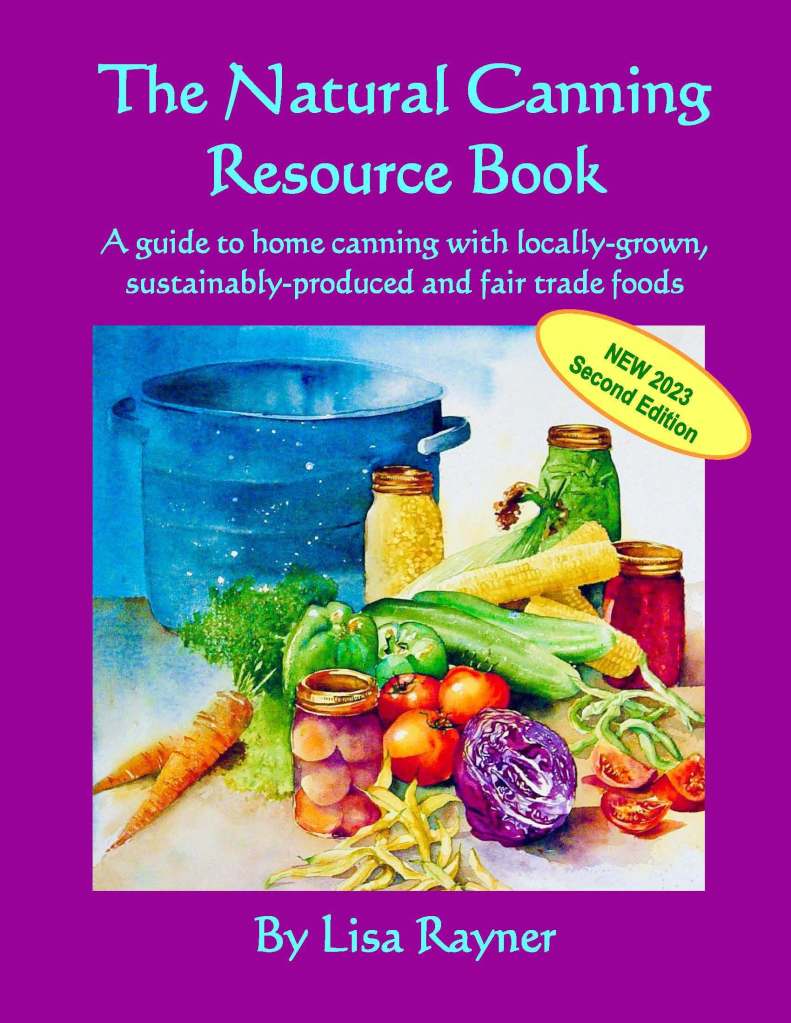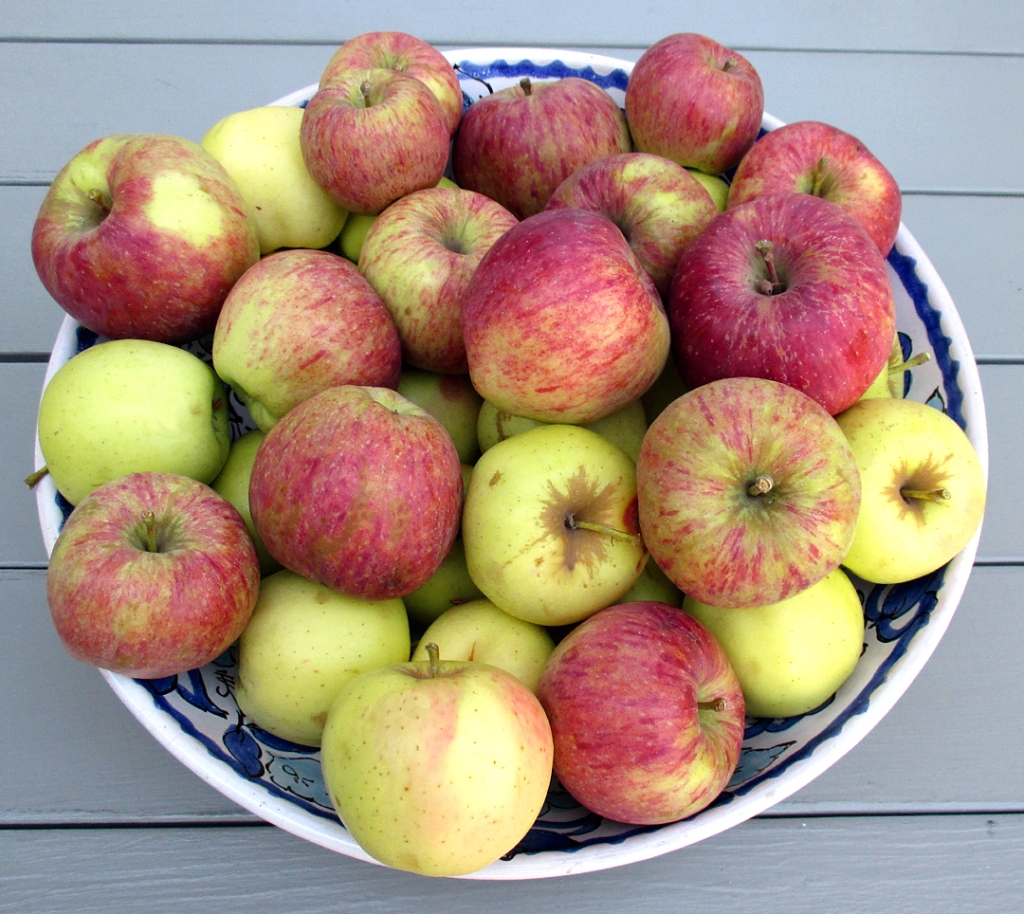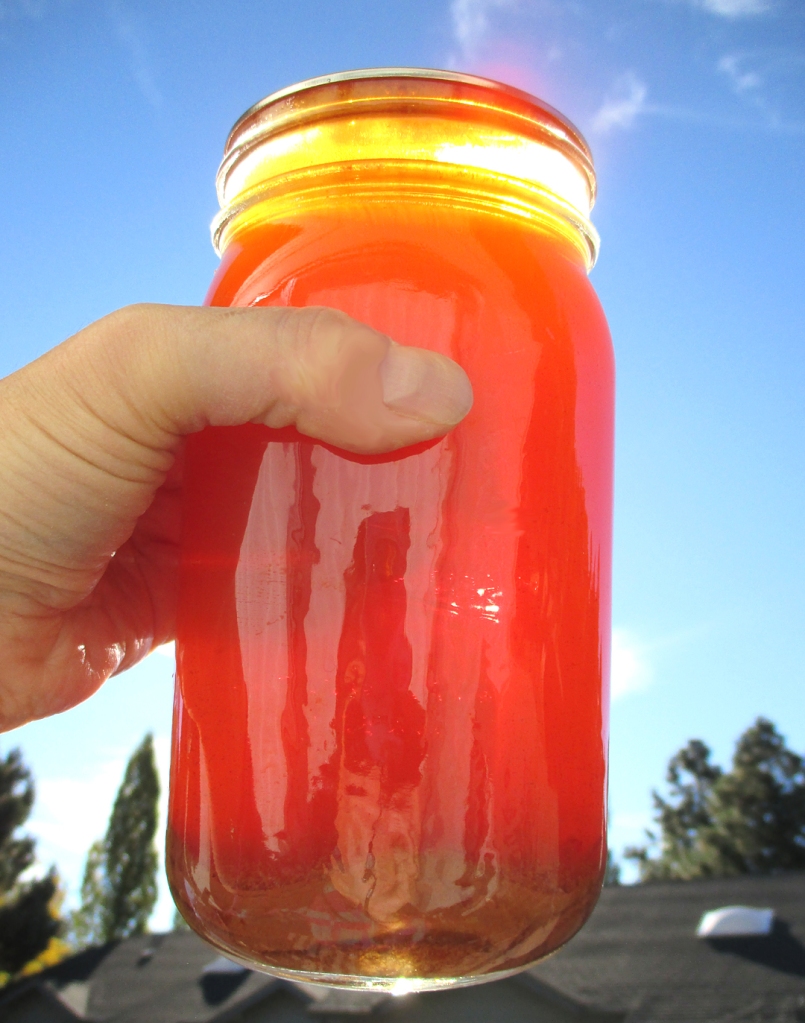The Natural Canning Resource Book: A guide to home canning with locally-grown, sustainably-produced and fair-trade foods, Second Edition © 2010, 2023 Lisa Rayner, Lisa Rayner Books. Print and Kindle editions on Amazon and an eBook version on Etsy. Follow Lisa at Lisa Rayner Books on Instagram.









The Natural Canning Resource Book: A guide to home canning with locally-grown, sustainably-produced and fair-trade foods, Second Edition, © 1996, 2023
© Lisa Rayner, Lisa Rayner Books, $9.95/$24.95 USD
204 pages, 8.5 x 11 inches
300+ black and white illustrations
ISBN 979-8-9879697-7-9
The Natural Canning Resource Book fills a major gap in the canning literature. Most canning recipes use non-organic, refined ingredients like distilled white vinegar, white sugar, corn syrup, and commercial pectin containing artificial preservatives. This book explains the science behind USDA canning guidelines from an author with a background in microbiology and chemistry. The book explores how to can foods and develop recipes using natural ingredients safely. Lisa’s interest in growing, preserving, and cooking sustainably with locally grown, fair trade foods began more than 30 years ago. Lisa is a certified permaculture designer, Master Gardener & was a 2009 Gardens for Humanity Visionary Awardee.
Learn how to:
- Can fruit & pickled foods without sweeteners. Or sweeten canned foods with honey,
- maple syrup, rice syrup, barley malt, agave syrup, date sugar, evaporated cane juice & other unrefined sugars.
- Can domesticated, tropical & wild fruit. Gel jams & jellies with homemade fruit pectin.
- Pickle vegetables with organic, unpasteurized apple cider vinegar or safe homemade vinegar.
- Can lactofermented veggies & fruit like kimchi, sauerkraut, cucumber pickles & pickled plums.
- Save money and energy with home canning.
- Can foods in a solar cooker safely.
- Can foods using American canning jars & European canning jars with glass lids.
- Create your own jam, jelly, conserve, fruit butter, pickle, relish, chutney & salsa recipes.
- Start a food preservation club, community canning project or community kitchen.
- Sell your canned foods at your local farmers’ market or community supported agriculture project.
“This is the best, most useful canning book I’ve ever owned. So full of information. I have learned so much that I’ve never understood from canning for 5 years reading other books in detail. Gets tot he important issues and is extremely thoughtful on environmental issues.” — Leah, Amazon reviewer
Table of Contents
Introduction
Part I: The science & economics of canning
Chapter 1: Why can?
Rediscovering a lost art
The place of canning in a sustainable future
Other ecological methods of food preservation
Home canning & a bioregional diet
A nutritional comparison of food preservation methods
Saving money through home canning
Why I chose to learn how to can food
Chapter 2: The history of canning & the USDA
The origins of canning
The development of USDA home canning guidelines
The science of creating canning recipes
Chapter 3: The microbiology of canning
Spoilage molds & bacteria & pathogenic bacteria
How factory farms make food safety more difficult
My scientific upbringing
Part II: The process of canning
Chapter 4: The canning kitchen
Stoves & canning
Pressure canners
Cooking pots
Other basic canning tools & equipment
Biocompatible cleaning & polishing recipes
Chapter 5: Canning jars & lids
Plastics & plastic additives in metal canning lids
Jarden lid system alternatives
Post carbon canning jar options
Chapter 6: Canning basics
Where to learn safe canning methods
Kitchen set-up & preparation for canning
Cold-pack versus hot-pack methods
Preparing jars, lids & food for canning
Water bath canning steps
Pressure canning steps
Spotting & safely discarding spoiled canned foods
Energy-saving canning tips
Storing & using canned food
Chapter 7: High altitude canning
High altitude boiling water bath canning
High altitude pressure canning
High altitude tips & tricks I’ve learned
Chapter 8: Solar canning
Using a solar cooker
What not to do: oven canning
Safe solar canning methods
Solar canning tips
Chapter 9: Community canning
Community canning projects
Community kitchens
A brief history of community kitchens & canning
Chapter 10: Developing new recipes & selling your goods
Modifying & creating new high acid canning recipes
Water activity
Measuring and adjusting pH
Measuring pasteurization temperature
Heat penetration & thermal processing time
Selling canned foods
Part III: Food & canning
Chapter 11: The modern forager
Food miles & carbon footprints
Obtaining local, organic & fair trade foods
Produce guide
Storing & washing produce
Preparing fruits & vegetables for canning
Other canning ingredients
Using & recycling food waste
Chapter 12: Sugar & canning
Sugar chemistry
Descriptions of different sweeteners
Water activity levels of liquid sweeteners
Sugar & pH
Deciding which sweeteners to use in canning recipes
Chapter 13: Fruit
Extracting & canning fruit juices
Canning whole & sliced fruit
Natural coloring for low sugar fruit syrups & preserves
Fruit sauces & purées (including homemade baby food)
Chapter 14: Preserves
Preserve making tips
What is pectin?
Sugar & the gelling process
Making do with less sugar & commercial pectin
Making your own pectin
Making jelly
Chapter 15: Acidified foods
Tomato & tomatillo products
Pickles, relishes & chutneys
Vinegar & canning
Oil & acidified foods
Chapter 16: Lactofermented foods
Lactofermentation bacteria
Sauerkraut & other dry-salted fermentations
Brine-pickled vegetables & fruit
Water bath canning lactofermented foods
Canning safety checklist
Appendix: Resources
Acknowledgements & About the author
Index
Introduction
Who is this book for?
This book is a comprehensive resource for anyone interested in learning how to
can with natural foods. I wrote this book with a certain demographic profile in
mind. Some of the following characteristics might apply to you:
- You might be a person whose parents or grandparents did not preserve food.
- You might live an urban or suburban lifestyle as opposed to a rural one.
- You might be earning less than your parents did at your age.
- You try to purchase organic whole foods when your budget permit
- You belong to a Community Supported Agriculture project or food cooperative, or
you prefer to shop at farmers’ markets and U-pick farms. Organic processed
foods like jam and salsa might be too expensive for your budget. - You are concerned about the climate emergency and human overstepping of
planetary ecological boundaries. - You are involved in community gardening, permaculture design, urban
foraging or guerilla gardening.
Why did I write this book?
This book is not a recipe book. It is designed to be used in conjunction with the
United States Department of Agriculture’s Complete Guide to Home Canning, 2015
revision, future revisions, and other USDA and Cooperative Extension publications.
There are plenty of canning recipe books available for purchase. However, most
have important gaps. For instance, many published canning recipes require the use
of distilled white or “cider” vinegar (sometimes not made from real apples), white
sugar, corn syrup, commercial pectin, or other refined products of the industrial
agriculture system. If you prefer natural foods and want to make jams and pickles
and salsas with natural sweeteners, organic vinegar or homemade pectin, few
resources are available on how to use them safely. Moreover, few canning books
explain the science behind canning safety guidelines. Why must certain rules be
followed for food safety?
You might have wondered if there are health,y sustainable alternatives.
Maybe you have a solar cooker and want to know how to solar can safely.
The USDA and Cooperative Extension System have done a lot of good research.
However, the USDA has a bias toward promoting big commodity agricultural
products like white sugar and corn syrup, and spends almost no time or money
promoting small, organic producers, or niche products like maple syrup. For this
reason, the USDA and Cooperative Extension publications, as well as big-name
canning book publishers like Ball® (whose parent company has a monopoly on
North American canning jar production) tend to pay little attention to the
interests of the local, organic food movement, permaculture movement, holistic
health, or to issues like the climate emergency and post-fossil fuel transition.
Moreover, the USDA publishes oversimplified explanations for home canners
that include built-in margins of safety. The food scientists who create home
canning publications assume that many of their audience members might not have
graduated from college or high school. Often, the reasoning behind canning rules
is not explained in enough detail for the general public to understand. Because most
canners do not have scientific academic backgrounds, discerning important
safety precautions from mere bias is difficult at best. “Just trust us—don’t you
dare experiment” is the implicit, and sometimes explicit, message. Indeed, one
government food scientist told me that the “USDA has never tried to be an
instructional guide on how to do your own in-home testing of ingredients.”
I wrote this book to help fill the void. I explore the multitude of possibilities for
the ecologically safe canning of locally grown foods. I don’t provide all of the
recipe details you’ll find in the Complete Guide to Home Canning, 2015 revision
—I want you to read it yourself; however, I do spend a fair amount of the book
explaining the science behind USDA guidelines so you can assess and
critique them knowledgeably.
To track down answers to these questions I conducted extensive research.
I contacted numerous government, university and industrial food scientists,
microbiologists and chemists. I also performed my own kitchen experiments.
Chapter 1 discusses how and why canning is an ecologically and economically
sustainable choice for food preservation: the role of canning in a post-petroleum
future, how to save money by canning at home, and a comparison of canning with
other ecologically sustainable methods of food preservation. Chapters 2 and 3
explain the history and science of canning in a way that non-scientists understand.
Learning about the basics of food microorganisms and heat processing of canned
foods will help you to understand better why the USDA has created certain rules
and—equally important—discern when those rules might be altered safely.
Chapter 4 explains what basic equipment you will need to begin your canning
adventures. This includes a thorough discussion of stoves and burners, water bath
and pressure canners and other useful canning equipment and utensils. Chapter 5
provides an in-depth look at canning jars and lids, including commercial reusable
canning jar and lid alternatives. Chapter 6 covers the processes of water bath and
pressure canning, including energy-saving canning tips, and how to store canned
goods. Chapter 7 is about high altitude canning and water bath processing foods
below the boiling point to better preserve the texture of canned foods. Chapter 8
explains how to safely use solar cookers for both water bath and pressure canning.
The most popular solar cooking websites contain unsafe canning information.
Learn how to do it safely. Chapter 9 is about working with neighbors to create
commercially-certified community kitchens. Chapter 10 explores the world of
creating your own canning recipes. Much of the information in that chapter will
help you make the most of the rest of the book. It also describes the Food and
Drug Administration’s guidelines for small-scale commercial canning and provides sources for would-be small canning entrepreneurs.
Chapter 11 is all about how and where to grow, forage or buy local, organic and fair
trade fruits, vegetables and herbs at the peak of freshness and prepare them for
canning. It also discusses where to buy other canning ingredients like bulk spices, sweeteners, salt, vinegar and oil. Learn about the world of Community Supported Agriculture Projects, local farmers’ markets, urban fruit foraging, guerilla gardening, community gardens and more. Chapter 12 explains how to safely can with natural sweeteners, a subject that the USDA and many canning books mostly ignore. Chapters 13 through 16 provide tips on water bath canning fruit, preserves, tomatoes, vinegar pickles, salsas, chutneys and lactofermented fruits and vegetables. At the end of chapter 16 is a canning safety checklist.
The appendix is a resource section with books, websites, and more on home canning-related subjects.
Return to Lisa Rayner Books homepage.

